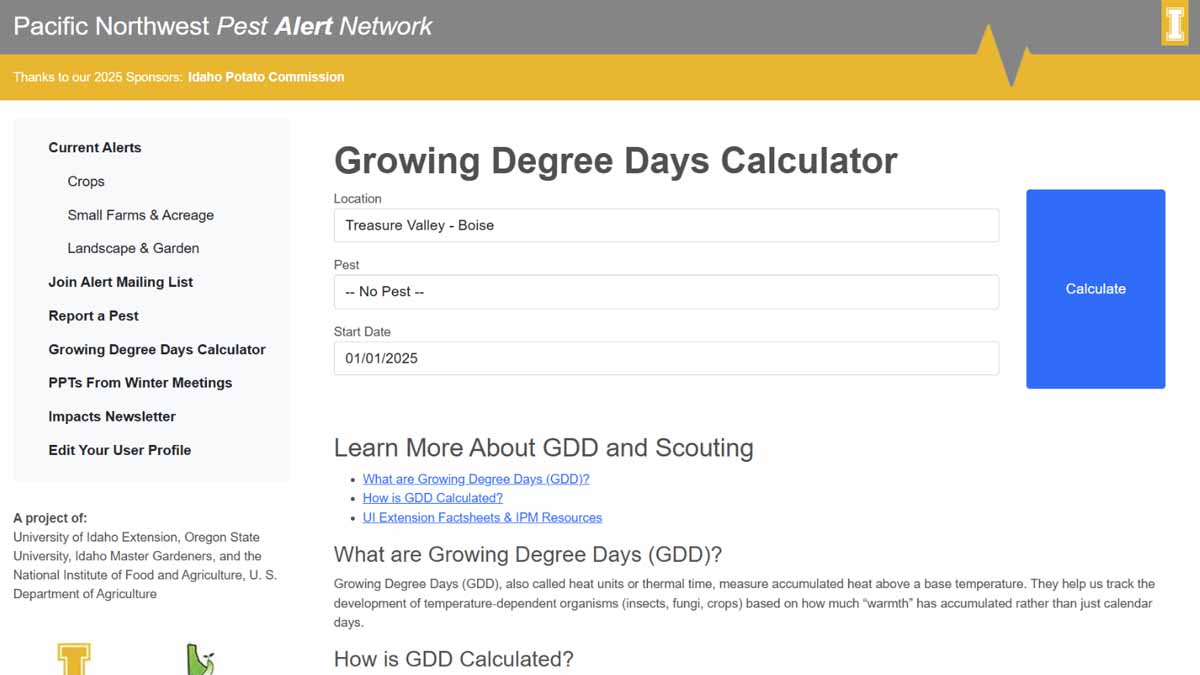Heat Calculator
August 13, 2025
A University of Idaho Extension scientist has developed an online tool to help farmers track how accumulated heat throughout the growing season affects the development of crops and important pests, helping them better time management decisions.
Several Treasure Valley farmers are already using the beta version of the Growing Degree Day Calculator and have consulted its creator, Jemilla Chellappa, an Extension area educator specializing in cropping systems, for guidance on how to apply it.
The calculator is linked to the Pacific Northwest Pest Alert Network website, operated by UI Extension, Idaho Master Gardeners, Oregon State University and the U.S. Department of Agriculture’s National Institute of Food and Agriculture to provide alerts to users about pest and disease threats affecting crops.
Chellappa is working to incorporate the state’s major crops into the calculator and has already added potatoes, sugarbeets, alfalfa, barley and wheat. The software uses site-specific calculations to pinpoint the growth stages of key pests and diseases affecting those commodities, including wireworms, alfalfa weevil, apple codling moth, cereal leaf beetle, onion thrips, potato psyllids, two-spotted spider mites and cercospora.
“With the successful launch of the Growing Degree Calculator on pnwpestalert.net, we now have a user-friendly, real-time tool to help farmers, researchers and advisors across the Pacific Northwest track crop development and pest stages based on temperature, not just the calendar,” Chellappa said. “For generations, farmers have turned to the calendar, but the calendar can’t tell you what the weather has or hasn’t done.”
The calculator draws localized data from the U.S. Bureau of Reclamation’s AgriMet network of automated weather stations.
Growers may adjust the date on the calculator to tally degree days from the date of planting or the start of the calendar year. Data from the calculator helps farmers avoid unnecessary chemical applications, while preventing them from missing ideal windows for spraying. Based on this season’s growing degree days, for example, the optimal timing for a wheat farmer in the Pocatello area to spray insecticide to control cereal leaf beetle would have been from June 5 through June 9 during the insect’s peak larval stage.
A growing degree day is calculated by averaging each day’s high and low temperatures and subtracting a specified base temperature, which is the lowest temperature at which a chosen crop will grow. For most of Idaho’s major crops the base temperature is about 50 degrees. For example, the growing degree calculation for a potato crop on a day with a high temperature of 95 degrees and a low temperature of 45 degrees would be the average of the two, 70 degrees, minus a base temperature of 50 degrees, equaling 20 degrees.
Chellappa plans to add additional crops, pests and diseases to the calculator, as well as features informing growers of the ideal timing for scheduling irrigation and applying fertilizer. The software incorporates Extension publications on pest and crop development and links to relevant Extension information. As new Extension bulletins and publications are published, Chellappa will use the data to further refine the calculator’s recommendations.
Chellappa realized the need for the calculator shortly after joining Extension in 2023. Growers who responded to a survey she administered said they wanted more specific guidance on spray scheduling. She couldn’t find much information to offer them, however. She considered the tools that were available to be complicated, and they didn’t clearly explain the concept of a growing degree day.
By enabling farmers to eliminate unnecessary chemical applications, this calculator also protects beneficial insects or biocontrol agents that predate on pests.
Furthermore, farmers can use the calculator to track whether their crops are progressing on schedule and to identify likely causes if crop development falls behind where the calculator indicates it should be.
Chellappa is seeking additional funding and collaborators to further develop the calculator.
“The calculator turns weather data into biological insight, helping you track growth stages and insect pest development using daily temperatures and known thresholds,” Chellappa said.

About the University of Idaho
The University of Idaho, home of the Vandals, is Idaho’s land-grant, national research university. From its residential campus in Moscow, U of I serves the state of Idaho through educational centers in Boise, Coeur d’Alene and Idaho Falls, nine research and Extension centers, plus Extension offices in 42 counties. Home to more than 12,000 students statewide, U of I is a leader in student-centered learning and excels at interdisciplinary research, service to businesses and communities, and in advancing diversity, citizenship and global outreach. U of I competes in the Big Sky and Western Athletic conferences. Learn more at uidaho.edu.






